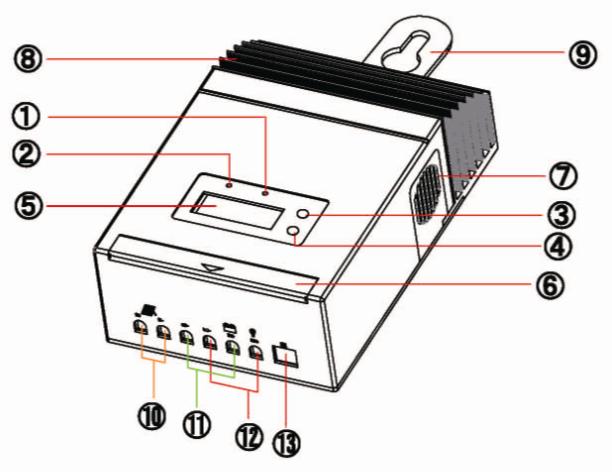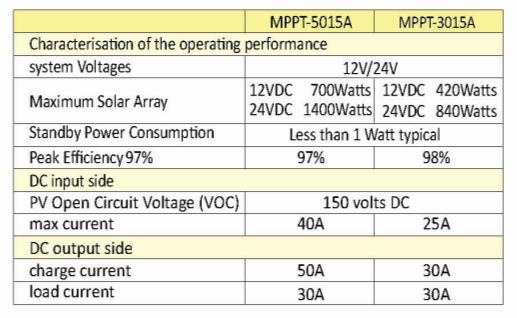SUN-MPPT-3015A Solar charge controller 30A
- Loading Port:
- Ningbo
- Payment Terms:
- TT OR LC
- Min Order Qty:
- -
- Supply Capability:
- 500 kg/month
OKorder Service Pledge
OKorder Financial Service
You Might Also Like
1.0 General Information
1.1 Overview
Thank you for selecting the MPPT solar charge controller.The MPPT is essentially a smart DC to DC converter which has been optimized to harvest maximum energy from the PV array in battery based solar electric systems by using a variety of maximum power point tracking (MPPT) strategies. The controller’s secondary objective is to ensure that the batteries receive a full charge without becoming overcharged. This is accomplished through a four stage charging process. Please take the time to read this operator’s manual and be familiar with the controller.This will help you make full use of the many advantages the MPPT can provide for your PV system.
1.2 Features
1 - Battery Status LED Indicator:An LED indicator that shows battery status or system errors.
2 - Charging Status LED Insdicator:An LED indicator that shows charging status and overvoltage of pv.
3 - Setting Button1:Set load work mode,battery type and max charge current.
4 - Setting Button2:Set load work mode,battery type and max charge current(in manual mode used for load ON/OFF).
5 - LCD Digital Display:Dispaly the system status
6 - Wiring Box Cover:Sheet metal wiring box cover protects power connections
7 - FAN:FAN to dissipate Internal circuit heat
8 - Heatsink:Aluminum heatsink to dissipate controller heat
9 - Mounting Hanger:Keyhole slot for mounting
10 - Solar Module Terminals:Connect solar modules
11 - Battery Terminals:Connect batteries
12 - Load Terminals:Connect loads
13 - RJ45 Communication Interface:Communicate with personal computer

2.0 General Information
The mounting location is important to the performance and operating life of the controller. The environment must be dry and protected from water ingress. If required, the controller may be installed in a ventilated enclosure with sufficient air flow. Never install the MPPT unit in a sealed enclosure. The controller may be mounted in an enclosure with sealed batteries, but never with vented/ flooded batteries. Battery fumes from vented batteries will corrode and destroy the MPPT circuits. Multiple MPPT can be installed in parallel on the same battery bank to achieve higher charging current. Additional parallel controllers can also be added in the future. Each MPPT must have its own solar array.
CAUTION: Equipment Damage or Risk of Explosion
Never install the MPPT in an enclosure with vented/Flooded batteries. Battery fumes are fl ammable and will corrode and destroy the MPPT circuits.
CAUTION: Equipment Damage
When installing the MPPT in an enclosure, ensure suffi cient ventilation. Installation in a sealed enclosure will lead to over-heating and a decreased product lifetime.
NOTE : Mounting
When mounting the MPPT ,ensure free air through the controller heat sink fins. There should be at least 150mm of clearance above and below the controller to allow for cooling. If mounted in an enclosure, ventilation is highly recommended.
3.0 Specifications
Electrical

NOTE:

All charging voltage setpoints listed are for 12 Volt systems. Multiply 2X for 24 Volt systems.
Battery Charging Charging algorithm 4 - stage Charging stages Bulk, Absorption, Float, Equalize Temperature compensation coeffcient -5 mV / °C / cell (25 °C ref.) Temperature compensated setpoints Absorption, Float, Equalize, HVD Charging Setpoints:
- Q:Can a solar controller be used with a solar panel cleaning system?
- Yes, a solar controller can be used with a solar panel cleaning system. A solar controller is responsible for regulating the power flow from the solar panels to the batteries or grid, ensuring optimal performance and protection. Using a solar controller in conjunction with a solar panel cleaning system can help monitor and control the power output, ensuring efficient cleaning operations without any potential damage to the panels.
- Q:Can a solar controller be used in a solar-powered water pump system?
- Yes, a solar controller can be used in a solar-powered water pump system. A solar controller regulates the amount of power generated by the solar panels and ensures that the batteries are charged optimally. Therefore, it is essential in maintaining the efficiency and longevity of the water pump system.
- Q:What is the maximum load power a solar controller can handle?
- The maximum load power that a solar controller can handle depends on the specific model and specifications of the controller. It can range from a few hundred watts to several kilowatts, depending on the controller's design and capabilities.
- Q:What is the cost of a solar controller?
- The cost of a solar controller can vary depending on several factors such as brand, capacity, features, and quality. On average, a basic solar controller can range from $20 to $50, while more advanced models with additional functionalities can cost anywhere from $50 to $200 or more.
- Q:What is the maximum number of system data logs supported by a solar controller?
- The maximum number of system data logs supported by a solar controller can vary depending on the specific model and manufacturer. It is recommended to refer to the product's specifications or contact the manufacturer directly to determine the exact number of system data logs supported.
- Q:Can a solar controller be used with a solar-powered outdoor lighting system?
- Yes, a solar controller can be used with a solar-powered outdoor lighting system. The solar controller helps regulate the power flow from the solar panels to the lighting system, ensuring maximum efficiency and preventing overcharging or damage to the batteries.
- Q:How do I ensure proper grounding for a solar controller?
- To ensure proper grounding for a solar controller, you should follow these steps: 1. Locate a suitable grounding point: Find a metallic structure, such as a grounded metal rod or a metal pipe, preferably close to the solar controller installation site. 2. Clear the grounding area: Remove any dirt, paint, or rust from the chosen grounding point to ensure a good electrical connection. 3. Connect the ground wire: Use a copper conductor or a grounding cable to connect the grounding point to the ground terminal on the solar controller. Make sure the connection is tight and secure. 4. Avoid sharp bends: Ensure the ground wire is not bent sharply, as this can impede the flow of electrical current. Instead, maintain gentle curves or use grounding clamps to navigate around obstacles. 5. Protect the ground wire: Safeguard the ground wire from physical damage or exposure to moisture by using conduit or other suitable protective measures. 6. Test the grounding: After installation, use a multimeter to verify that the ground wire is properly connected and has low resistance to earth. This will ensure that the solar controller is effectively grounded. By following these steps, you can ensure proper grounding for your solar controller, which helps protect against electrical surges and improves system safety and performance.
- Q:Can a solar controller be used with solar battery storage systems?
- Indeed, solar battery storage systems can be utilized in conjunction with a solar controller. Referred to as a charge controller, the solar controller's purpose is to govern the influx of charge into the batteries, thereby avoiding overcharging and prolonging their lifespan. Its primary function is to guarantee that the solar panels are effectively and efficiently charging the batteries. Consequently, when employing a solar battery storage system, the inclusion of a solar controller becomes imperative to ensure the accurate charging and upkeep of the batteries.
- Q:Can a solar controller be used with a solar-powered commercial building?
- Yes, a solar controller can be used with a solar-powered commercial building. A solar controller helps regulate and optimize the charging and discharging of batteries in a solar power system. It ensures that the energy generated by the solar panels is efficiently stored and managed, allowing for reliable and consistent power supply to the building.
- Q:Can a solar controller be used with a solar-powered billboard or signage?
- Yes, a solar controller can be used with a solar-powered billboard or signage. A solar controller is used to regulate and optimize the charging and discharging of batteries in a solar power system. In the case of a solar-powered billboard or signage, the solar controller helps to manage the flow of electricity from the solar panels to the batteries, ensuring efficient and reliable power supply for the signage.
1. Manufacturer Overview |
|
|---|---|
| Location | |
| Year Established | |
| Annual Output Value | |
| Main Markets | |
| Company Certifications | |
2. Manufacturer Certificates |
|
|---|---|
| a) Certification Name | |
| Range | |
| Reference | |
| Validity Period | |
3. Manufacturer Capability |
|
|---|---|
| a)Trade Capacity | |
| Nearest Port | |
| Export Percentage | |
| No.of Employees in Trade Department | |
| Language Spoken: | |
| b)Factory Information | |
| Factory Size: | |
| No. of Production Lines | |
| Contract Manufacturing | |
| Product Price Range | |
Send your message to us
SUN-MPPT-3015A Solar charge controller 30A
- Loading Port:
- Ningbo
- Payment Terms:
- TT OR LC
- Min Order Qty:
- -
- Supply Capability:
- 500 kg/month
OKorder Service Pledge
OKorder Financial Service
Similar products
New products
Hot products
Hot Searches
Related keywords


























